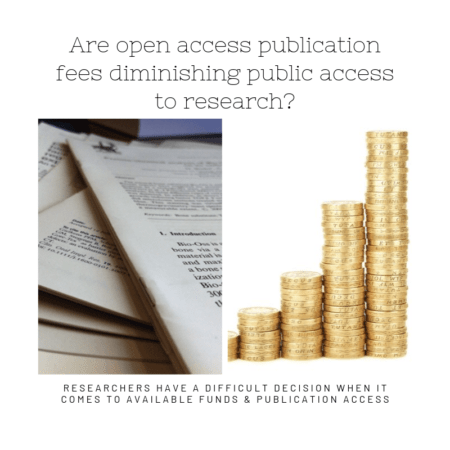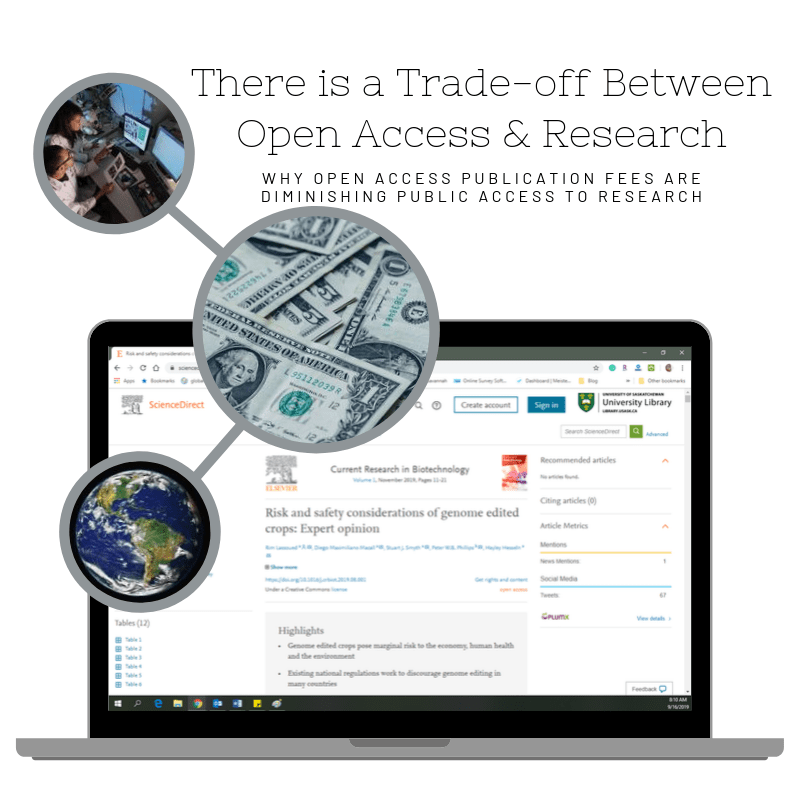The skyrocketing cost of science and academic journal open access fees
In the past month, I’ve been fortunate to have two articles accepted for journal publication. Publishing research is the key component of my academic work and research. While I am thrilled to have had two articles accepted for publication, making both public accessible (a.k.a. open access), totaled $6,152.38 from my research accounts. I recently had a third article accepted, costing a whopping $3,689.14 (US$2,800) in open access fees. I want these three articles to be available to the public, academics and students at other universities and people who work in industry and government. Yet the cost to make my research publicly accessible totals $9,841.52.

My concern with this is that my research program is producing numerous papers per year, yet my research funds aren’t sufficient to pay the high open access fees for all of the papers. Between July 2018 and June 2019, my research team and I successfully published 10 journal articles. Had I opted to pay the full open access fee on all of these articles, it would have cost my research program $36,711.43. When I write new research grant proposals, I budget about $10,000 per year in publication charges. While I am part of a couple of research grants at the moment, I often need to share the funds available to pay publication charges with my other colleagues that are part of the grant and I commonly receive enough funds to cover the publication open access fees for one article. The challenge with trying to budget more accurately is that it’s not possible to predict what the charges will be, as until the paper is written, I don’t know which journal to submit to, nor which one will accept it for publication. Likewise, budgeting $35,000 a year in publication charges, would raise a red flag, reducing my chances that the research grant would be successful.
Public research costs of open access
Open access fees vary from journal to journal. High impact journals charge higher amounts than lower impact journals. The advantage of publishing in a journal with a high impact factor is that these journals have higher rates of article downloads, which leads to higher citation rates. Academics strive to publish in the highest impact journals as possible.
Given that my research program receives public funding, I strongly believe that I should publish all of my research to be open access. Knowing the high cost of doing this, I have two options:
- I can publish in lower impact journals, with lower fees and I can publish more articles as open access with the funds I have available. Or,
- I can select a small number of publications for high impact journals, pay the open access fee for these and not pay the fee for all of the other articles that are published.
This is a difficult decision. In some instances, the research collaborations with my students will be published in journals, but the open access fee will not be paid. In other instances, good articles in good journals will not be open access as there will be no funds available to pay the fees. There is also a timing issue, working within a yearly budget and not knowing the magnitude of your results mid research. Articles for publication are spaced out, making it difficult to know at the beginning of the year which you will want to allot a higher publishing fee to and how you should plan out the fees for the year.
Most people outside of academics will say, ‘who cares’ or ‘big deal’ if it costs me a lot of research funds for open access publications. I’m just one academic who cares if my research is publicly available. Putting this into context, if each academic in Canada foregoes paying the open access fee for one paper, there would be 45,000 fewer articles publicly available. The concern is that with public funding being such an important part of academic research if the public doesn’t have to access this research, there is a tendency to be less supportive of publicly funded research. Open access is important in ensuring the continued support of public research funding.
Personally, I think the move to charge academics open access fees to publish their research is reducing the public good from investing in research as less of it is accessible to the public. This is not a benefit to society and the problem is going to worsen given the rising cost of open access fees. This cost will be most highly borne by young academics as their research funds are typically of lower amounts. Open access publication fees are a problem, with no solution.


I sympathise Stuart with the difficulties in budgeting. At Technopolis, we are currently undertaking a study of the academic publishing market in Europe, where there is strong government support to move to open access. It’s interesting to see that the market is actually evolving quickly, and large publishers clearly have strategic motivations in ALL pricing decisions. A relevant questions to add to your musings is whether the profits earned by a rather small oligopoly is in the public interest. Those are based on both subscription fees and open access fees.